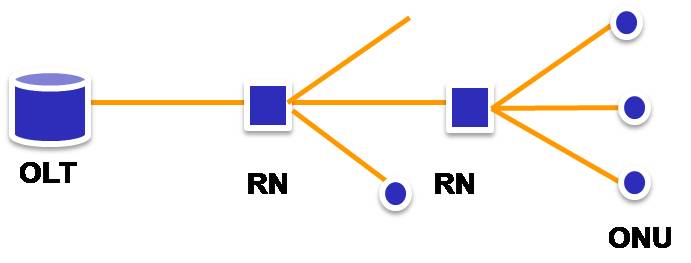Next generation access network will require flexible deployment, large capacity, easy upgradability to serve more users and longer reach (over 100km). Current standardization bodies such as ITU and IEEE are investigating various NGA architectures based on these requirements. However, because of longer reach and increased capacity, future access network would be more vulnerable to various failure conditions such as fiber cuts and equipment failures. Therefore, new NGA proposals must consider fault-tolerant architectures to minimize various failure impacts on access network. Basically, protection of access network is usually performed by duplicating fibers or equipments to be protected. Full protection of access network could be easily accomplished by fully duplicating whole network elements. However, these kinds of naive approach would significantly increase cost of deployment such as CAPEX. Therefore, economically meaningful deployment cost should be considered as well.
To meet the requirements on resiliency of NGAs, DAN project focuses on analysis of failure impacts on NGAs and development of economically meaningful fault-tolerant architectures. Key research areas of DAN are:
- Investigation of Important NGA Architectures: Tree Architecture PON, Cascaded Tree Architecture PON, Ring-Tree Architecture PON and Ring-Star Architecture PON
- Analysis of Failure Impacts on NGA Networks: Probability of Failure on Individual User Links and Failure Penetration Range
- Assessment of Resiliency, Performance Tradeoff and Cost of NGA: Comparison of proposed fault-tolerant NGAs in terms of costs, power consumption and resiliency
Dan Project will cover above research areas in depth and we will propose robust and economically sensible NGA architectures. Possibly, this project can be extended to build NGA testbed to obtain experimental data for evaluation of failure metrics and integrate novel protection mechanisms investigated in NGA testbed. Based on the testbed, higher layer network experiments also can be performed for performance evaluation and protocol development for the proposed NGA architecture.
Recent Research Direction
Important Next Generation Access Architecture
- Cascaded Tree Architecture

Motivations: Current Tree Architecture PON has a limitation in reach ( ~20km). Cascaded tree architecture extends its reach up to around 100 km by using optical amplifiers.
Examples: SuperPON and CWDM PON
- Ring-Tree Architecture

Motivations: Ring architecture improves resilience on the feeder fiber. As in the figure above, any remote node (RN) is connected to the central office with two ring feeder fiber. Therefore, any fiber cut of them can be quickly healed by redirecting transmitting and receiving signals to other ring fiber.
Examples: SUCCESS H-PON (Hybrid WDM/TDM System)
- Ring-Stars Advanced Architecture

Motivations: Ring-Stars architecture provide extra resilience with ring architecture. Due to its extra feeder fiber redundancy, this architecture can protect failures from multiple fiber cuts.
Types of Failure Modes
- Fiber Cuts: Depending on the architecture and the location of the cut, a single fiber cut could affect service of all users, a subgroup of users or a single user.
- Equipment Failures: In addition to OLT and ONU failures, NGA might use additional equipments in the distribution network. Their failure modes and impacts must be accessed
- Malicious Attacks: Potentially serving thousands of customers, NGA must protect against malicious attack.
Failure Impacts and Assessment of Failure Costs
- Metrics for Impact of Failure Modes
- Depends on the types of failures: the failures in time (FIT), mean time to repair (MTTR), total unavailability => different operational (OPEX) impact.
- Need to identify all failure modes in the NGA architectures.
- Assessment of Failure Costs on NGA Architectures
- The types and impact of failure are different for different NGA architectures
- New mitigation techniques could be employed to enhance resiliency
- Component costs and resiliency tradeoff must also be considered